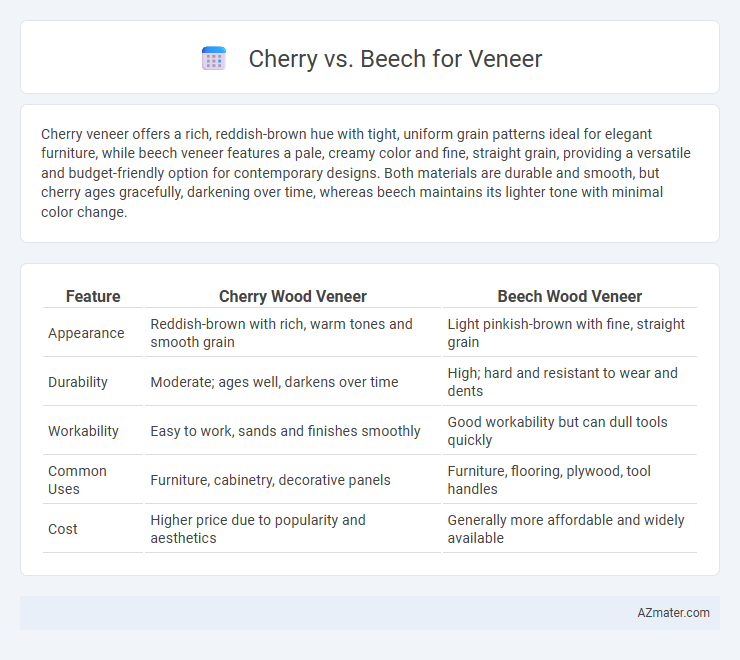Cherry veneer offers a rich, reddish-brown hue with tight, uniform grain patterns ideal for elegant furniture, while beech veneer features a pale, creamy color and fine, straight grain, providing a versatile and budget-friendly option for contemporary designs. Both materials are durable and smooth, but cherry ages gracefully, darkening over time, whereas beech maintains its lighter tone with minimal color change.
Table of Comparison
| Feature | Cherry Wood Veneer | Beech Wood Veneer |
|---|---|---|
| Appearance | Reddish-brown with rich, warm tones and smooth grain | Light pinkish-brown with fine, straight grain |
| Durability | Moderate; ages well, darkens over time | High; hard and resistant to wear and dents |
| Workability | Easy to work, sands and finishes smoothly | Good workability but can dull tools quickly |
| Common Uses | Furniture, cabinetry, decorative panels | Furniture, flooring, plywood, tool handles |
| Cost | Higher price due to popularity and aesthetics | Generally more affordable and widely available |
Overview: Cherry vs Beech Veneer
Cherry veneer offers a rich, warm reddish-brown hue with a smooth grain that deepens over time, making it ideal for elegant furniture and cabinetry. Beech veneer features a pale, creamy color with a fine, straight grain that provides a neutral, versatile appearance suitable for modern and classic designs. Both veneers are hardwoods prized for durability and workability, but Cherry's distinctive coloring contrasts with Beech's lighter, more uniform aesthetic.
Botanical Origins and Wood Characteristics
Cherry veneer, derived from Prunus serotina, exhibits a rich reddish-brown hue that deepens with age, known for its fine, straight grain and smooth texture enhancing aesthetic appeal. Beech veneer, sourced from Fagus sylvatica, features a pale cream to light reddish-brown color with a uniform, tight grain and a durable, dense wood structure favored for strength and stability. Both woods offer distinctive botanical origins and wood characteristics influencing veneer selection for furniture and interior design applications.
Color and Grain Pattern Differences
Cherry veneer boasts a rich, warm reddish-brown color that deepens and darkens with age, offering a smooth, fine grain pattern with subtle waves and occasional small knots. Beech veneer, on the other hand, presents a lighter, creamy beige hue with a uniform, straight grain that is often tighter and more consistent than cherry. These distinct color and grain pattern differences influence the choice of veneer for projects requiring either warmth and elegance from cherry or brightness and simplicity from beech.
Durability and Hardness Comparison
Cherry veneer offers moderate hardness with a Janka rating of approximately 950, making it durable for light to medium use in furniture and cabinetry. Beech veneer exhibits higher hardness, with a Janka scale rating near 1,300, providing superior resistance to dents and wear in high-traffic applications. The greater hardness and density of Beech make it the preferred choice for durability-demanding veneer projects compared to the softer, more easily dented Cherry.
Workability and Machining Properties
Cherry veneer exhibits excellent workability due to its fine, uniform grain and moderate hardness, allowing for smooth cutting and minimal splitting during machining. Beech veneer offers superior machinability with its consistent texture and higher density, enabling precise shaping and sanding while maintaining minimal tear-out. Both veneers respond well to adhesives and finishes, but Cherry's softer nature makes it more forgiving in detailed applications, whereas Beech's durability suits heavier-duty projects.
Aesthetic Appeal in Interior Design
Cherry veneer offers a warm, reddish-brown tone with fine, straight grain patterns that enhance elegance and sophistication in interior design. Beech veneer features a pale, creamy color with a subtle, uniform grain, providing a neutral and versatile aesthetic ideal for contemporary or minimalist spaces. The choice between Cherry and Beech veneers depends on the desired atmosphere, with Cherry creating rich, classic environments and Beech promoting light, airy interiors.
Cost and Availability Analysis
Cherry veneer typically commands a higher price due to its rich color and fine grain, making it a premium choice in furniture and cabinetry. Beech veneer is generally more cost-effective and widely available, favored for its light color and uniform texture which suits mass production. The availability of beech is greater in North America and Europe, whereas cherry is more regionally sourced, impacting cost based on supply chain factors.
Sustainability and Environmental Impact
Cherry veneer is favored for its renewable growth rate and moderate carbon sequestration, making it a sustainable choice when sourced from responsibly managed forests certified by FSC or PEFC. Beech veneer, with its dense grain and higher durability, supports longevity in products, reducing the need for frequent replacements and lessening environmental impact over time. Both species require sustainable harvesting practices to minimize deforestation, but cherry's faster re-growth cycle generally offers a lower ecological footprint compared to beech.
Common Applications and Use Cases
Cherry veneer is widely used in fine furniture, cabinetry, and musical instruments due to its rich, warm tones and smooth grain that enhances aesthetic appeal. Beech veneer, recognized for its light color and uniform texture, is commonly applied in modern furniture, flooring, and plywood manufacturing, offering excellent durability and resistance to wear. Both veneers serve diverse interior design needs, with cherry preferred for classic elegance and beech favored for contemporary, minimalist styles.
Choosing the Right Veneer: Cherry or Beech?
Cherry veneer offers a rich, warm reddish-brown tone that deepens with age, making it ideal for elegant, classic furniture designs. Beech veneer features a light, creamy color with a fine grain, providing a versatile and modern aesthetic suitable for contemporary interiors. Durability and ease of workability favor Beech for high-traffic surfaces, while Cherry's distinctive aging and luxurious appearance appeal to traditional craftsmanship.

Infographic: Cherry vs Beech for Veneer
 azmater.com
azmater.com